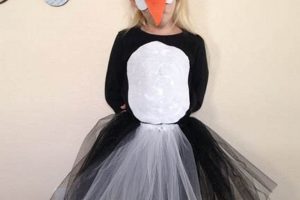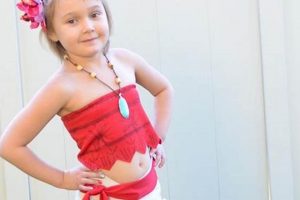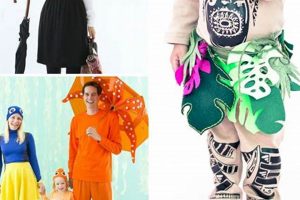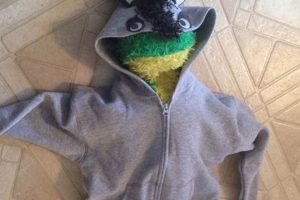The creation of angelic raiment through do-it-yourself methods provides an avenue for individuals to personalize symbolic attire. This process encompasses the design and construction of garments, wings, and halos, utilizing readily available materials to achieve a desired aesthetic for various events, such as theatrical productions, holiday celebrations, or costume parties. For example, one might employ feathered boas, wire hangers, and shimmering fabrics to fashion wings, complementing them with a flowing white dress and a self-made halo.
Engaging in the independent construction of such apparel offers several advantages. It presents a cost-effective alternative to purchasing pre-made costumes, allowing for budgetary control and resourcefulness. Furthermore, it encourages creativity and self-expression, enabling individuals to tailor the design to their specific preferences and requirements. Historically, crafting personal garments was a common practice, fostering a connection to tradition and resourcefulness. The contemporary resurgence of these activities highlights a desire for personalized, sustainable options.
The subsequent sections will explore specific techniques for crafting wings, designing halos, and selecting appropriate fabrics, providing detailed instructions to facilitate the creation of unique and memorable angelic attire.
Crafting Angelic Attire
The creation of angelic raiment requires careful consideration of design, materials, and construction techniques. Adhering to the following guidelines will enhance the final product’s aesthetic appeal and durability.
Tip 1: Material Selection: Prioritize lightweight and shimmering fabrics such as tulle, organza, or satin for ethereal qualities. Avoid heavy materials that restrict movement or appear cumbersome.
Tip 2: Wing Proportions: Determine appropriate wing size relative to the wearer’s height. Wings that are disproportionately large can appear awkward, while those that are too small may lack visual impact. Construct a prototype from cardboard to assess the desired scale.
Tip 3: Feather Application: Secure feathers meticulously using a combination of glue and stitching. Overlap feathers strategically to create a layered effect, concealing the underlying structure. Consider the type of feather – goose or turkey feathers offer greater coverage than smaller craft feathers.
Tip 4: Halo Construction: Opt for a lightweight wire frame for the halo to ensure comfort and stability. Wrap the frame with ribbon, fabric, or metallic tinsel for a polished appearance. Secure the halo to a headband or comb for secure attachment.
Tip 5: Embellishments: Incorporate subtle embellishments such as sequins, beads, or glitter to enhance the costume’s visual appeal. Apply these sparingly to avoid overwhelming the design.
Tip 6: Structural Integrity: Reinforce the wing structure with sturdy wire or dowels to prevent drooping or breakage. Ensure all components are securely attached to withstand movement and handling.
Tip 7: Comfort and Mobility: Prioritize comfort and ease of movement. Avoid restrictive designs or embellishments that hinder mobility. Test the costume thoroughly before wearing it for extended periods.
By implementing these recommendations, individuals can create visually striking and structurally sound angelic attire suitable for various occasions. Emphasis on material quality, proportional design, and secure construction will yield superior results.
The ensuing section provides detailed instructions for executing specific aspects of the costume’s construction, including wing assembly and halo fabrication.
1. Feather selection
Feather selection represents a critical determinant in the aesthetic and functional success of a do-it-yourself angel costume. The type, size, color, and texture of the feathers directly influence the visual impact and overall construction of the wings, a primary component of the costume. Inferior feather quality or inappropriate selection can result in a visually unappealing or structurally unsound design, impacting the costume’s realism and durability. For example, using brittle craft feathers may create a sparse and fragile wing structure, whereas employing larger, more robust goose or turkey feathers yields a fuller and more resilient appearance. Thus, the choice of feathers is not merely a cosmetic consideration, but a foundational element in the construction process.
The practical significance of careful feather selection extends to the costume’s overall comfort and wearability. Heavier feathers, while offering greater visual density, can contribute to increased weight, potentially causing discomfort for the wearer, especially over extended periods. Furthermore, the arrangement and attachment of feathers directly affect the wing’s flexibility and range of motion. Poorly applied feathers can restrict movement and create an unbalanced or cumbersome feel. Therefore, individuals undertaking the construction of angelic attire must carefully weigh the visual appeal against the practical considerations of comfort and functionality.
In summary, feather selection is inextricably linked to the outcome of a do-it-yourself angel costume. The choice of feathers influences not only the aesthetic impression but also the structural integrity and comfort of the final product. While visually appealing options may be tempting, a comprehensive understanding of feather properties and their impact on both construction and wearability is crucial for achieving a successful and satisfying result. Challenges may arise in sourcing specific feather types or balancing visual appeal with practical considerations; however, a thoughtful and informed approach to feather selection is essential for realizing a compelling angelic vision.
2. Wing framework
The wing framework constitutes a foundational element in the creation of an angelic costume through do-it-yourself methods. The framework serves as the structural basis upon which the wings are built, influencing their shape, size, durability, and overall aesthetic appeal.
- Material Selection for Structure
The choice of materials for the framework dictates the wings’ weight, flexibility, and resilience. Common materials include wire, cardboard, foam, and plastic. Wire allows for malleable shapes but may require reinforcement for larger wings. Cardboard provides a lightweight option but may lack durability. Foam offers a balance of lightness and strength. Plastic, while durable, can be less adaptable to intricate designs. The selection should align with the intended design and anticipated wear conditions. For instance, wire frameworks are beneficial for articulated wings, while foam boards serve well for basic, static designs.
- Shape and Size Considerations
The framework directly determines the wing’
s shape and size, critical factors in achieving the desired visual impact. Symmetry and proportion are essential. Frameworks can be designed to mimic various avian wing shapes, from the broad wings of an eagle to the delicate wings of a butterfly. Accurate measurements and templates are necessary to ensure the wings complement the wearer’s proportions. For example, oversized wings may overwhelm a petite individual, while undersized wings may lack presence. - Attachment and Stability
The framework must incorporate a secure attachment mechanism to ensure the wings remain firmly affixed to the wearer. Options include straps, harnesses, and direct attachment to clothing. The attachment point should be robust enough to withstand the weight and movement of the wings. Instability can lead to discomfort and potential damage. Secure attachment design might involve reinforced stitching, strategically placed supports, or adjustable straps to accommodate various body types.
- Feather Application and Coverage
The framework design must consider how feathers will be applied and secured. A well-designed framework provides ample surface area for adhesive or stitching. The framework should also allow for overlapping feathers to create a full and realistic appearance. Gaps or exposed framework can detract from the overall aesthetic. For example, a wire framework may require fabric backing to provide a smooth surface for feather attachment.
These facets underscore the interconnectedness of the framework with the overall design and execution of a do-it-yourself angelic costume. A well-conceived and executed framework provides the necessary foundation for creating visually appealing, durable, and comfortable wings, integral to the costume’s success. Its strategic implementation exemplifies resourceful craftsmanship and attention to detail, vital for effective costume construction.
3. Halo construction
Halo construction represents a critical element in the creation of angelic attire via do-it-yourself methods. It directly contributes to the overall aesthetic and symbolic representation of the costume, reinforcing its theme. The following facets delineate crucial aspects of halo construction within this context.
- Material Selection and Symbolic Representation
Material choices for halo construction significantly impact its visual representation. Wire frames covered in white fabric evoke traditional depictions of purity and divinity. Metallic elements, such as gold or silver wire, connote celestial brilliance and status. Incorporating natural materials, like woven twigs or floral accents, can introduce a more earthly, ethereal quality. The selection mirrors the specific interpretation of angelic representation the creator aims to convey. For example, a rustic halo of interwoven branches aligns with depictions of nature spirits or earthbound angels.
- Structural Integrity and Wearability
The halos structural integrity must balance aesthetic considerations with practical wearability. Lightweight materials are paramount to prevent discomfort and ensure secure placement. Techniques for securing the halo to the wearers head range from discreet headbands to strategically placed combs or pins. Inadequate structural design or attachment can lead to instability, detracting from the costumes visual impact. For example, an improperly balanced halo may tilt or fall, disrupting the overall angelic image.
- Customization and Personal Expression
Halo construction offers significant opportunities for customization and personal expression. Adornments such as sequins, beads, feathers, or miniature lights can enhance the halos visual appeal and reflect individual artistic preferences. Intricate designs, personalized motifs, or unique color palettes can distinguish the halo and elevate the costume beyond a generic representation. For example, a halo embellished with iridescent crystals might signify a connection to celestial realms or a specific angelic order.
- Integration with Overall Costume Design
The halo should integrate seamlessly with the overall costume design, complementing the style, color palette, and thematic elements of the angelic attire. A cohesive design approach ensures a unified and aesthetically pleasing presentation. Disconnects between the halo and the rest of the costume can create visual dissonance and detract from the intended effect. For example, a highly ornate halo may appear incongruous with a simple, minimalist dress, disrupting the costumes harmony.
These facets illustrate the interconnectedness of halo construction with the broader endeavor of creating angelic attire through do-it-yourself means. Careful consideration of materials, structure, customization, and integration ensures a successful and visually compelling representation of angelic symbolism.
4. Fabric draping
Fabric draping, in the context of constructing angelic attire, constitutes a pivotal determinant in achieving the desired aesthetic and ethereal quality. It encompasses the artful manipulation of textiles to create flowing lines, graceful silhouettes, and a sense of otherworldly elegance. The manner in which fabric is draped directly influences the perceived volume, texture, and movement of the costume, thereby shaping its overall impact. For example, strategically gathered chiffon can simulate the appearance of voluminous wings, while a cascade of draped satin can evoke a sense of celestial light. Without skilled fabric draping, even the finest materials may fail to convey the desired angelic impression.
The practical application of fabric draping extends beyond mere aesthetics; it impacts the comfort and functionality of the costume. A well-draped garment allows for freedom of movement and prevents restriction, crucial for performance or extended wear. Techniques such as creating strategically placed pleats, folds, and gathers can enhance the garment’s shape while ensuring a comfortable fit. Furthermore, the draping method affects the distribution of weight, influencing how the fabric falls and interacts with the wearer’s body. For instance, a gown with carefully draped layers can create a flattering silhouette, concealing imperfections and enhancing the wearer’s form.
In summary, fabric draping is an indispensable skill in the creation of impactful angelic attire. Its mastery not only enhances the visual appeal of the costume but also contributes to its comfort and wearability. Challenges may arise in selecting appropriate fabrics, mastering draping techniques, and achieving the desired level of visual complexity. However, a thorough understanding of these principles is essential for transforming simple materials into a captivating representation of angelic grace and beauty. This intricate art directly contributes to the authenticity and impact of the angelic image, essential for a successful costume.
5. Secure fastenings
Secure fastenings are paramount in the successful construction of any do-it-yourself angel costume. The integrity of the design hinges on the reliable attachment of components such as wings, halos
, and various decorative elements. Inadequate fastening methods can lead to costume malfunctions, detracting from the visual impact and potentially causing discomfort or embarrassment to the wearer.
- Wing Attachment Integrity
Wings, often the most visually prominent feature, require robust and discreet fastening mechanisms. Simple glue or weak stitching may fail under the stress of movement, causing the wings to detach. Superior methods involve sturdy harnesses, reinforced straps, or strategically placed wire supports integrated into the garment’s structure. For instance, a lightweight wire frame sewn directly to the back of a bodice provides a more stable foundation than adhesive alone.
- Halo Stabilization Techniques
Halos, prone to shifting or falling, necessitate secure attachment to the head. Simple headbands can be insufficient, particularly for heavier or more elaborate designs. More effective techniques include combs sewn into the halo base to grip the hair, adjustable elastic straps for a snug fit, or discreet wire loops that can be pinned to the hairstyle. A halo that remains firmly in place enhances the costume’s overall effect.
- Decorative Element Security
Smaller decorative elements, such as feathers, sequins, or ribbons, require secure attachment to prevent loss during wear. Adhesive alone is often inadequate for long-term security. A combination of glue and stitching provides a more reliable bond. For example, individual feathers can be secured with a small dab of fabric glue and then stitched at the base for added reinforcement.
- Costume Closure Reliability
The overall closure of the costume itself, whether a dress, robe, or tunic, demands secure and reliable fastenings. Zippers, hooks and eyes, or ties must be robust enough to withstand movement and prevent wardrobe malfunctions. Reinforced stitching and quality materials are essential. For example, a zipper with a locking mechanism or multiple hooks and eyes provides a more secure closure than a single, flimsy hook.
These considerations demonstrate the critical role of secure fastenings in the creation of a durable and visually effective do-it-yourself angel costume. Emphasizing robust attachment methods ensures the costume remains intact and maintains its aesthetic integrity throughout its use.
6. Comfort
Comfort represents a crucial, yet often overlooked, aspect of do-it-yourself angelic attire. While visual appeal and symbolic accuracy are primary considerations, the wearability and comfort level of the costume significantly impact the wearer’s experience and overall satisfaction. A visually stunning costume that is uncomfortable to wear will detract from the intended effect, potentially limiting its use.
- Fabric Selection and Breathability
The choice of fabric directly affects the costume’s breathability and skin contact comfort. Heavy, non-breathable fabrics such as thick velvet or non-porous synthetics can trap heat and moisture, leading to discomfort and potential irritation. Lightweight, breathable fabrics like cotton, linen, or silk blends allow for air circulation, promoting comfort during extended wear. For instance, a flowing gown constructed from lightweight cotton voile will be significantly more comfortable than one made from heavy synthetic brocade, particularly in warmer environments.
- Wing Weight and Ergonomics
The weight and design of the wings are critical to comfort. Large, heavy wings can strain the back, shoulders, and neck, causing discomfort and fatigue. Utilizing lightweight materials such as foam or flexible wire for the wing framework, combined with a secure and ergonomic attachment system, can mitigate this issue. Distributing the weight evenly across the shoulders and back, rather than concentrating it on a single point, enhances comfort. For example, a padded harness system distributes the weight of the wings more effectively than simple elastic straps.
- Halo Fit and Pressure Points
An ill-fitting halo can create pressure points on the head, leading to discomfort and headaches. Careful consideration must be given to the halo’s size, shape, and attachment method. Adjustable headbands, padded linings, and lightweight materials can enhance comfort. Avoiding rigid or sharp edges that press against the scalp is essential. A halo that conforms to the wearer’s head shape and distributes pressure evenly will minimize discomfort.
- Seam Construction and Friction Reduction
Rough or poorly finished seams can cause chafing and irritation, especially in areas of high friction such as under the arms or around the neckline. Utilizing flat-felled seams or serged edges reduces bulk and minimizes friction. Soft, smooth linings can further enhance comfort by creating a barrier between the costume’s outer fabric and the skin. Paying attention to seam placement and finishing is crucial for creating a comfortable and wearable angelic costume.
These elements highlight the interconnectedness of design, material selection, and construction techniques in achieving a comfortable and enjoyable do-it-yourself angelic costume. While visual appeal remains important, prioritizing comfort ensures the wearer can fully embody the character without physical discomfort hindering the experience. Ignoring comfort considerations can compromise the entire project, regardless of its aesthetic merits. A comfortable angel costume allows for confident and graceful embodiment of the character.
Frequently Asked Questions About DIY Angel Costumes
The following questions address common inquiries and concerns regarding the creation of angelic attire through do-it-yourself methods. The aim is to provide clarity and guidance on various aspects of the construction process.
Question 1: What is the estimated cost for creating a do-it-yourself angel costume?
The cost varies significantly depending on material choices and design complexity. Simple costumes constructed from repurposed fabrics and basic craft materials may cost under $20. More elaborate designs employing higher-quality fabrics, intricate embellishments, and professionally constructed wings can range from $50 to $150 or more. Budgeting for materials is crucial before commencing the project.
Question 2: How much time is required to construct a do-it-yourself angel costume?
The time commitment depends on skill level and the intricacy of the design. A basic costume can be completed in a few hours, while more complex projects may require several days or weeks. Factor in time for design planning, material acquisition, construction, and fitting.
Question 3: What are the essential tools and materials required for construction?
Essential tools include a sewing machine, scissors, measuring tape, pins, needles, and a hot glue gun. Core materials comprise fabric (such as tulle, satin, or organza), feathers, wire (for halo and wing frames), ribbon, thread, and embellishments. Access to a well-lit and spacious work area is also beneficial.
Question 4: How does one create realistic-looking wings?
Achieving realistic wings involves a combination of structural design and feather application. Construct a lightweight yet sturdy frame using wire or foam. Apply feathers in overlapping layers, starting from the base and working outwards, to create a natural appearance. Utilizing different sizes and textures of feathers enhances realism.
Question 5: What methods are employed for securing a halo effectively?
Secure halo attachment requires a stable base and a reliable fastening mechanism. Common methods include attaching the halo to a headband, utilizing combs to grip the hair, or employing elastic straps for a snug fit. The attachment method should be discreet and comfortable, ensuring the halo remains securely in place without causing discomfort.
Question 6: What safety precautions should be observed during costume construction?
Safety precautions include using sharp tools with care, wearing eye protection when using a hot glue gun, and ensuring adequate ventilation when working with adhesives or paints. Test the costume for potential hazards, such as sharp edges or loose embellishments, before wearing it.
DIY angel costumes can range from simple to complex designs, and attention to detail and safety will ensure a successful and enjoyable creation.
The subsequent section provides detailed instructions on maintaining and storing the completed costume to prolong its lifespan and preserve its aesthetic appeal.
Conclusion
The preceding sections have comprehensively explored the multifaceted aspects of diy angel costume creation. From material selection and wing framework construction to fabric draping and secure fastening techniques, the information presented aims to equip individuals with the knowledge necessary to craft visually appealing and durable angelic attire. Successful execution necessitates careful planning, attention to detail, and a commitment to both aesthetic principles and functional considerations.
The construction of a diy angel costume extends beyond mere fabrication; it embodies a convergence of creativity, resourcefulness, and personalized expression. The enduring appeal of this activity lies in its capacity to transform readily available materials into a tangible representation of ethereal beauty and symbolic meaning. Continued exploration and refinement of these techniques will undoubtedly contribute to the evolving landscape of costume design and individual artistic endeavors.







